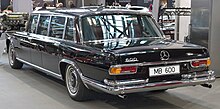This article needs additional citations for verification. (September 2010) |
| Mercedes-Benz 600 (W100) | |
|---|---|
 | |
| Overview | |
| Manufacturer | Daimler-Benz |
| Also called |
|
| Production |
|
| Assembly | West Germany: Stuttgart |
| Designer | |
| Body and chassis | |
| Class | Ultra-luxury car Limousine |
| Body style | |
| Layout | FR layout |
| Powertrain | |
| Engine | 6.3 L M100 V8 |
| Dimensions | |
| Wheelbase | SWB: 3,200 mm (126.0 in) LWB: 3,900 mm (153.5 in) |
| Length | SWB: 5,580 mm (219.7 in) LWB: 6,340 mm (249.6 in) |
| Width | 1,950 mm (76.8 in) |
| Height | SWB: 1,500 mm (59.1 in) LWB: 1,510 mm (59.4 in) |
| Curb weight | 2,990–3,280 kg (6,592–7,231 lb) |
| Chronology | |
| Predecessor | |
| Successor | Mercedes-Benz S 600 (600 SWB; 1993–present) (Spiritual Successor) Maybach 57 and 62 (600 Pullman; 2002–2012) (True Successor) Mercedes-Maybach S 600 (600 LWB; 2015–present) (Spiritual Successor) |





The Mercedes-Benz 600 (W100) is a line of ultra-luxury cars produced by Daimler-Benz from 1963 to 1981. The forerunner of the modern Maybach marque, the Grosser Mercedes ("Grand Mercedes") succeeded the Type 300d "Adenauer" (W189) as the company's flagship model. It was positioned above the subsequent 300-series (W112) in price, amenities, and status. In 1963 the Mercedes-Benz 600 was the most expensive car in the world. Its few competitors included British and American equivalents such as Rolls-Royce, Bentley, Lincoln Continental, Cadillac Series 75, and Imperial. It was well known for its ownership among celebrities and political leaders and royalty throughout the late 20th century.[2] Many experts and enthusiasts consider it to be the greatest luxury vehicle ever made. Even today owning a Mercedes-Benz 600 can be very expensive and extremely costly to maintain, they can cost as much as 3.5 million dollars.[citation needed]
Generally, the short-wheelbase (SWB) models were designed to be owner-driven, whereas the long-wheelbase (LWB) and limousine models, often incorporating a central divider with power window, were intended for chauffeur operation.
- ^ Oswald, Werner [in German] (2001). Deutsche Autos [German Cars] (in German). Vol. Band [Volume] 4: 1945–1990 Audi, BMW, Mercedes, Porsche und andere [and others]. Stuttgart: Motorbuch Verlag. p. 54. ISBN 3613021315.
- ^ "History of engineering: the Grand Mercedes 600". Mercedes Benz. Retrieved 2024-08-17.